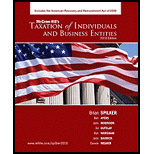
Taxation Of Individuals And Business Entities, 2010 Edition
1st Edition
ISBN: 9780073526966
Author: Brian Spilker, Benjamin Ayers, John Robinson, Edmund Outslay, Ronald Worsham, John Barrick, Connie Weaver
Publisher: McGraw-Hill/Irwin
expand_more
expand_more
format_list_bulleted
Question
Chapter 15, Problem 1DQ
To determine
List the most common legal entities that are used for operating a business. Discuss how these entities are similar and different for state law purposes.
Expert Solution & Answer
Explanation of Solution
The following are the most common legal entities that are used for operating a business:
- Corporations.
- Limited liability Companies (LLCs).
Partnerships .- Sole Proprietorships.
The following are the similarity of the above entities for state law purposes:
- The state laws protect all the members or owners of Corporations and LLCs from personal legal entities.
- Corporations, Limited liability Companies (LLCs), and Partnerships are identified as business entities for state law purposes.
The following are the differences among the above entities for state law purposes:
- The legal rights and responsibilities, and number of owners of each entity are different from other.
- The tax rule to determine tax on the entities and their owners are different from each other.
Want to see more full solutions like this?
Subscribe now to access step-by-step solutions to millions of textbook problems written by subject matter experts!
Students have asked these similar questions
Oriole Co. has the following transactions related to notes receivable during the last 2 months of the year. The company does not make
entries to accrue interest except at December 31.
Nov. 1
Loaned $54,600 cash to C. Bohr on a 12-month, 8% note.
Dec. 11
Sold goods to K. R. Pine, Inc., receiving a $1,800, 90-day, 7% note.
Received a $14,400, 180-day, 6% note to settle an open account from A. Murdock.
16
31
Accrued interest revenue on all notes receivable.
Journalize the transactions for Oriole Co. (Omit cost of goods sold entries.) (List all debit entries before credit entries. Credit account titles
are automatically indented when amount is entered. Do not indent manually. Record journal entries in the order presented in the problem. Use
360 days for calculation. If no entry is required, select "No Entry" for the account titles and enter O for the amount in the relevant debit OR credit
box. Entering zero in ALL boxes will result in the question being marked incorrect.)
Date
Account…
Hello tutor please given general accounting question answer do fast and properly explain all answer
I want to this question answer for general accounting question not need ai solution
Chapter 15 Solutions
Taxation Of Individuals And Business Entities, 2010 Edition
Knowledge Booster
Similar questions
arrow_back_ios
SEE MORE QUESTIONS
arrow_forward_ios
Recommended textbooks for you
- Century 21 Accounting Multicolumn JournalAccountingISBN:9781337679503Author:GilbertsonPublisher:Cengage
 Individual Income TaxesAccountingISBN:9780357109731Author:HoffmanPublisher:CENGAGE LEARNING - CONSIGNMENT
Individual Income TaxesAccountingISBN:9780357109731Author:HoffmanPublisher:CENGAGE LEARNING - CONSIGNMENT

Century 21 Accounting Multicolumn Journal
Accounting
ISBN:9781337679503
Author:Gilbertson
Publisher:Cengage


Individual Income Taxes
Accounting
ISBN:9780357109731
Author:Hoffman
Publisher:CENGAGE LEARNING - CONSIGNMENT


